NWS Raleigh Science Program
The purpose of the science program is to ensure that science and technology are used effectively in forecast and warning operations to fulfill the mission of the NWS. The utilization of science often requires research, many times with collaborative partners in NOAA, academia, and other members of the weather enterprise. Implementing science effectively requires frequent training with both atmospheric and hydrologic science as well as technology and software.
One of the country's strongest collaborative research relationships between a National Weather Service (NWS) office and a university started in Raleigh in the late 1970's. The process began when meteorologists from the NWS and NC State started collaborating on various projects including internships, seminars, and jointly participating in American Meteorological Society (AMS) meetings. The relationship grew during the 1980's and 1990's with projects such as the Genesis of Atlantic Lows Experiment, the Southeast Consortium on Severe Thunderstorms and Tornadoes, and various COMET projects. In 1994, the NWS office moved and became collocated with NC State University. In the following years, NWS Raleigh co-sponsored the first AMS regional workshop for operational forecasters and hosted a National Weather Association annual meeting. NWS Raleigh has participated in three NOAA Collaborative Science, Technology, and Applied Research (CSTAR) projects and nearly a dozen COMET projects. The office participates in several NC State meteorology courses, a student internship course for credit, and has hosted numerous student volunteers. Research and science results have been published in several journals, presented in countless conferences, and shared with other NWS offices.
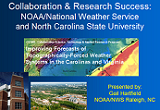 A much more thorough and detailed History of the NWS Raleigh Science Program and Collaboration is available.
A much more thorough and detailed History of the NWS Raleigh Science Program and Collaboration is available.
A power point presentation illustrating the collaboration & research success between the NWS Raleigh and North Carolina State University is also available.
For many years, the National Weather Service in Raleigh and North Carolina State University have worked together to improve forecast and warning services in the Carolinas. One result of these collaborative efforts has been a better understanding of forecast problems found in the southeast and has often resulted in operational schemes that have helped NWS meteorologists forecast these meteorological phenomena. In addition to the various research projects undertaken, the collaboration also allows students the opportunity to participate in formal internships, to work alongside forecasters, and to volunteer on various projects at the NWS office.
NC State Student Course Website
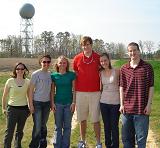
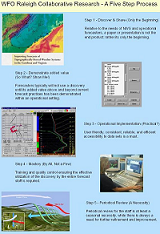 For many years, the National Weather Service in Raleigh and North Carolina State University have worked together to study forecast problems found in the southeast. One result of this collaborative relationship have been improved operational techniques that have helped NWS meteorologists forecast these meteorological phenomena.
For many years, the National Weather Service in Raleigh and North Carolina State University have worked together to study forecast problems found in the southeast. One result of this collaborative relationship have been improved operational techniques that have helped NWS meteorologists forecast these meteorological phenomena.
The transition of Research into Operations, often referred to as R2O, is a critical part of this collaborative relationship. At times the relationship takes an O2R2O framework where operational meteorologists bring problems to the researcher's attention who in turn provide improved techniques to the meteorologists.
The joint collaborations, whether they are R2O or O2R2O, are viewed as a 5-Step Process, whereby research findings ultimately are integrated into operations.
 A large part of the collaboration has been facilitated with grants to support several large projects including three NOAA Collaborative Science, Technology, and Applied Research (CSTAR) projects and nearly a dozen Cooperative Program for Operational Meteorology, Education and Training (COMET) projects.
A large part of the collaboration has been facilitated with grants to support several large projects including three NOAA Collaborative Science, Technology, and Applied Research (CSTAR) projects and nearly a dozen Cooperative Program for Operational Meteorology, Education and Training (COMET) projects.
The latest information on these or any collaborative project is located on the National Weather Service - NC State Collaborative Research & Training Site.
CSTAR Projects
COMET Projects
CIFLOW
Southeast University Consortium for Severe Storms
Genesis of Atlantic Lows Experiment (GALE)
Forecast, Training, and CSTAR Workshop Presentations
Collaboration Teletraining
Data and Products
References and Conceptual Models
Software, Local Applications, Smart Tools, and AWIPS Procedures
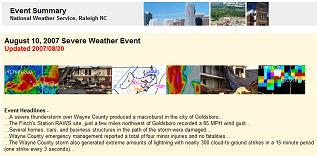 The NWS Raleigh has a long tradition of providing event summaries and case studies for significant and unique meteorological events. The event summaries, case studies, and event maps serve many purposes including: a means to improve our meteorological understanding, a summary of the event for use as a training tool, a means to evaluate the station's performance (determining the training needs of the station and for individuals), and a review of the event for general interest needs. Our inventory of cases is well over 140 and it continues to grow.
The NWS Raleigh has a long tradition of providing event summaries and case studies for significant and unique meteorological events. The event summaries, case studies, and event maps serve many purposes including: a means to improve our meteorological understanding, a summary of the event for use as a training tool, a means to evaluate the station's performance (determining the training needs of the station and for individuals), and a review of the event for general interest needs. Our inventory of cases is well over 140 and it continues to grow.
Catalog of Event Summaries, Case Studies and Event Maps
NWS Raleigh staff members have presented both oral presentations and poster presentations at various conferences, meetings, and workshops. Some of the more recent presentations are shown below.
Not Just a Number: Intra-Hour Heat Metric Variability Emily Nagamoto. Summer 2023 Undergraduate Research & Creativity Symposium, July 2023
An Analysis of BUFKIT Methodologies to Forecast Wind and Wind Gust Speed for the Southern Appalachians Thomas Green. Southern Appalachian Weather and Climate Workshop, March 2022
Implementing an Enhanced Flash Flood Climatology for Central North Carolina Andrew Kren, Barrett Smith, and Daniel Leins. Southern Appalachian Weather and Climate Workshop, March 2022
Urban Heat Island Mapping in Raleigh and Durham, North Carolina Gail Hartfield. AMS Annual Meeting, January 2022
Developing an Enhanced Flash Flood Climatology for Central North Carolina Barrett Smith, Andrew Kren, and Daniel Leins. 46th NWA Annual Meeting, August 2021
The Utility of Supplemental Low Elevation Radar Data in Tornado Warning Decision-Making in central NC Michael Strickler and Daniel Leins. 45th NWA Annual Meeting, September 2020
Examining an Extremely Wet Year across Central North Carolina Kathleen Pelcynzski, James Danco, and Jonathan Blaes. 44th NWA Annual Meeting, September 2019.
The 2018 Greensboro Tornado: Challenges of Surveying and Providing Relief in an Urban Environment Ryan Ellis and Donald Campbell. 44th NWA Annual Meeting, September 2019.
Exploring Damaging Winds During Extratropical Transition of Tropical Storm Michael over North Carolina. Brian Haines, Michael Strickler, Ryan Ellis, and Gail Hartfield. 44th NWA Annual Meeting, September 2019.
Tornadic Storm Mode across the Southern Appalachian Mountains. James Morrow, Steve Keighton. 44th NWA Annual Meeting, September 2019.
Collaborative Effort to Predict Hourly Temperatures during the August 21, 2017 Total Solar Eclipse in the Mid-Atlantic and Southeast. Jonathan Blaes, Gail Hartfield and Joshua Weiss. 43rd NWA Annual Meeting, August 2018.
Assessment of Crystal Characteristics and Snowfall Impact During the North Carolina Snowstorm of 17 January 2018. Gail Hartfield and Frank Alsheimer. 43rd NWA Annual Meeting, August 2018.
Analysis of Fatalities across North Carolina Resulting from Hurricane Matthew. Jonathan Blaes and Brandon Locklear. 98th American Meteorological Society Annual Meeting, January 2018.
Using Wind Profilers to Examine Non-Convective Low-Level Wind Shear in North Carolina. Ryan T. Ellis. 98th American Meteorological Society Annual Meeting, January 2018.
Analysis of Fatalities across North Carolina Resulting from Hurricane Matthew. Jonathan Blaes Brandon Locklear. 42nd NWA Annual Meeting, August 2017.
Assessing the Impacts of Extreme Heat Episodes on Vulnerable Populations in North Carolina. Gail Hartfield, Lauren Thie and Kelly Squires. 42nd NWA Annual Meeting, August 2017.
Hurricane Matthew: An Ideal Setup for Catastrophic Flooding in Central North Carolina. Keith D. Sherburn and Jonathan Blaes. 28th Conference on Severe Local Storms, November 2016.
Using Wind Profilers to Examine Non-Convective Low-Level Wind Shear in North Carolina. Ryan Ellis, Barrett Smith, and Katie Dedeaux. 41st NWA Annual Meeting, September 2016.
Investigating the December 2015 Central North Carolina “Superfog” Event. Gail Hartfield. 41st NWA Annual Meeting, September 2016.
Environmental Conditions Associated with North Carolina Tornadoes. Keith D. Sherburn and Jonathan Blaes. 41st NWA Annual Meeting, September 2016.
A Detailed Climatology of Central North Carolina Tornadoes. Raelene Campbell, Jonathan Blaes, and Brandon Locklear. 40th NWA Annual Meeting, September 2015.
Operations to Research to Operations Experiences with a North Carolina State-National Weather Service Collaborative Science, Technology, and Applied Research (CSTAR) Project. Jonathan Blaes and Dr. Gary Lackmann. 39th NWA Annual Meeting, October 2014.
Developing a Dataset of Wind Gust Factors to Improve Forecasts of Wind Gusts in Tropical Cyclones. Jonathan Blaes, Ryan T. Ellis, Donald Reid Hawkins, David A. Glenn, and Victoria Oliva. 39th NWA Annual Meeting, October 2014.
Orographically Induced Cirrus Clouds In the Lee of the Southern Appalachian Mountains. Ryan Ellis, Jonathan Blaes, and Lindsey Anderson. 39th NWA Annual Meeting, October 2014.
Investigation of Extreme Lightning Days in North Carolina. Gail Hartfield and Jonathan Blaes. 39th NWA Annual Meeting, October 2014.
A Climatology of Warm Season Cold Air Damming and Tropical Cyclones in the Southeast U.S.. Barrett Smith, Jonathan Blaes, José Garcia and Jordan Dale. 39th NWA Annual Meeting, October 2014.
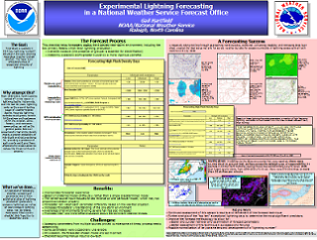 Developing a Dataset of Wind Gust Factors to Improve Forecasts of Wind Gusts in Tropical Cyclones (Recorded presentation). Jonathan Blaes, NWS Raleigh, NC; David A. Glenn, NWS Newport, NC; and Donald Reid Hawkins, NWS Wilmington, NC. 2013 Fall ER Science Sharing Conference, November 2013. - Not available at this time
Developing a Dataset of Wind Gust Factors to Improve Forecasts of Wind Gusts in Tropical Cyclones (Recorded presentation). Jonathan Blaes, NWS Raleigh, NC; David A. Glenn, NWS Newport, NC; and Donald Reid Hawkins, NWS Wilmington, NC. 2013 Fall ER Science Sharing Conference, November 2013. - Not available at this time
Orographically Induced Cirrus Clouds East of the Southern Appalachian Mountains. Ryan T. Ellis, NWS Raleigh, NC. Prepared for the 38th NWA Annual Meeting, October 2013.
Investigation of Extreme Lightning Days in North Carolina. Gail Hartfield and Jonathan Blaes, NWS Raleigh, NC and Gary Lackmann, Michael Graves, and Lindsey Anderson, North Carolina State University, Raleigh, NC. Prepared for the 38th NWA Annual Meeting, October 2013.
A Climatology of Cold Air Damming and Tropical Cyclones in the Southeast U.S.. Jonathan Blaes, NWS Raleigh, NC; José Garcia, North Carolina Agricultural and Technical State University, Greensboro, NC; and Jordan Dale, North Carolina State University, Raleigh. NC Prepared for the 38th NWA Annual Meeting, October 2013.
Developing a Dataset of Wind Gust Factors to Improve Forecasts of Wind Gusts in Tropical Cyclones. Jonathan Blaes, NWS Raleigh, NC; David A. Glenn, NWS Newport, NC; and Donald Reid Hawkins, NWS Wilmington, NC. Prepared for the 38th NWA Annual Meeting, October 2013.
Hurricane Ernesto (2006): Frontal Influence on Precipitation Distribution. Barrett Smith, NWS Raleigh, NC, Jordan Dale, and Gary Lackmann, North Carolina State University. 37th NWA Annual Meeting, October 2012.
An 8 Year Lightning Climatology of North Carolina. Jonathan Blaes, NWS Raleigh, NC and Morgan Brooks, NWS Milwaukee/Sullivan, WI. Central NC Chapter of the AMS, March 2012. - Not available at this time
Improving Methods to Forecast Mixing Heights at the NWS Raleigh. Jonathan Blaes, Phil Badgett, and Gail Hartfield, NWS Raleigh, NC. 2012 North Carolina Wildland Fire Alliance and Cooperators Meeting, February 2012. - Not available at this time
Central North Carolina Tornadoes From the 16 April 2011 Outbreak | [multimedia version with audio]. Matthew Parker, North Carolina State University, Jonathan Blaes, NWS Raleigh, Gary Lackmann, and Sandra Yuter, North Carolina State University. AMS Special Symposium on the Tornado Disasters of 2011, January 2012. - Not available at this time
An 8 Year Lightning Climatology of North Carolina. Morgan Brooks, NWS Milwaukee/Sullivan, WI, Jonathan Blaes and Gail Hartfield, NWS Raleigh, NC. 36th NWA Annual Meeting, October 2011.
Verifying Forecasts of Maximum Mixing Height for Greensboro, NC. Jonathan Blaes and Phillip Badgett, NWS Raleigh, NC. 36th NWA Annual Meeting, October 2011.
A Multiple Source Approach to Operational Lightning Prediction. Gail Hartfield, NWS Raleigh, NC. 91st AMS Annual Meeting, January 2011. - Not available at this time
Orographically Induced Cirrus Clouds East of the Southern Appalachian Mountains. Ryan Ellis, NWS Raleigh, NC. 2010 Virtual Satellite Workshop hosted by the NWS Charleston, SC, November 2010. - Not available at this time
Examination of a Winter Storm Using a Micro Rain Radar and AMDAR Aircraft Soundings. Barrett Smith and Jonathan Blaes, NWS Raleigh, NC. 2010 National Weather Association Annual Meeting, October 2010. - Not available at this time
Orographically Induced Cirrus Clouds East of the Southern Appalachian Mountains. Ryan Ellis, NWS Raleigh, NC. AMS 17th Conference on Satellite Meteorology and Oceanography, September 2010.
Using AMDAR Aircraft Observations in Forecast and Warning Operations at the Raleigh Forecast Office. Jonathan Blaes, NWS Raleigh, NC. Central NC Chapter of the AMS, November 2009. - Not available at this time
The Effects of Dry Air Ridging on the Rainfall Distribution of Tropical Storm Hanna. Barrett Smith and Jonathan Blaes, NWS Raleigh, NC. 2009 National Weather Association Annual Meeting, October 2009.
Using AMDAR Aircraft Observations at the National Weather Service Forecast Office Raleigh, North Carolina. Barrett Smith and Jonathan Blaes, NWS Raleigh, NC and Jason Beaman, NWS Mobile, AL. 2009 National Weather Association Annual Meeting, October 2009.
Overview of North Carolina Climate. Phillip Badgett, NWS Raleigh, NC. HMT NOAA Hydrometeorology Testbed-Southeast Research and Planning Workshop, June 2009. - Not available at this time
The Effects of Dry Air Ridging on the Rainfall Distribution of Tropical Storm Hanna. Barrett Smith and Jonathan Blaes, NWS Raleigh, NC. Conference on the Inland Impacts of Tropical Cyclones (IITC), June 2009. - Not available at this time
Experimental Lightning Forecasting in a National Weather Service Forecast Office. Gail Hartfield, NWS Raleigh, NC. AMS Fourth Conference on the Meteorological Applications of Lightning Data, January 2009. - Not available at this time
Non-traditional Convective Storm Verification Methods. Jonathan Blaes, NWS Raleigh, NC. NWS Newport, NC Hurricane Conference, June 2008. - Not available at this time
NWS RAH Aviation Initiatives. Jason Beaman, NWS Raleigh, NC. NWS Charleston, SC Sub-Regional Aviation Workshop, March 2008. - Not available at this time
NWS Raleigh staff members have authored numerous articles in various publications and made countless presentations to a variety of conferences and workshops. A listing of the articles published in peer reviewed publications is shown below.
Stuart, N. A., Gail Hartfield, David M. Schultz, and Coauthors, 2022: The Evolving Role of Humans in Weather Prediction and Communication. Bull. Amer. Meteor. Soc., 103, E1720–E1746, https://doi.org/10.1175/BAMS-D-20-0326.1.
Parker, M.D., J.L. Blaes, G.M. Lackmann, and S.E. Yuter, 2012: Central North Carolina Tornadoes from the 16 April 2011 Outbreak. Preprint for the Special Symposium on the Tornado Disasters of 2011, 92nd AMS Annual Meeting, January 25, 2012, New Orleans, Louisiana. Extended Abstract
Van Cooten, Suzanne, and Coauthors, 2011: The CI-FLOW Project: A System for Total Water Level Prediction from the Summit to the Sea. Bull. Amer. Meteor. Soc., 92, 1427-1442. Extended Abstract
Hartfield, G.I., 2011: A Multiple Source Approach to Operational Lightning Prediction. Preprint 5th Conference on the Meteorological Applications of Lightning Data, 91st AMS Annual Meeting, January 22-27, 2011, Atlanta, Georgia. Extended Abstract
Ellis R., and Businger S., 2010: Helical Circulations in the Typhoon Boundary Layer. Journal of Geophysical Research, 115, 13 pp. Abstract
Smith, B.L., S.E. Yuter, P.J. Neiman, and D.E. Kingsmill, 2010: Water Vapor Fluxes and Orographic Precipitation over Northern California Associated with a Landfalling Atmospheric River. Mon. Wea. Rev., 138, 74–100. Abstract
Yuter, S. E., D. A. Stark, M. T. Bryant, B. A. Colle, L. B. Perry, J. Blaes, J. Wolfe, and G. Peters, 2008: Forecasting and characterization of mixed precipitation events using the MicroRainRadar. Abstracts, Fifth European Conference on Radar in Meteorology and Hydrology. June 2008, Helsinki, Finland. Preprint
Locklear, C.B., 2008: A Severe Weather Climatology for the Raleigh, NC, County Warning Area. NOAA Tech. Memo. NWS ER-101. 24 pp.
Schneider, D., and S. Sharp, 2007: Radar Signatures of Tropical Cyclone Tornadoes in Central North Carolina. Wea. Forecasting, 22, 278–286. Abstract
Brennan, M.J., K. Keeter, A.J. Riordan, and G.M. Lackmann, 2005: Expanding Horizons with an NWS Internship Course. Bull. Amer. Meteor. Soc., 86, 1407–1409. Abstract
Bailey, C.M., G. Hartfield, G.M. Lackmann, K. Keeter, and S. Sharp, 2003: An Objective Climatology, Classification Scheme, and Assessment of Sensible Weather Impacts for Appalachian Cold-Air Damming. Wea. Forecasting, 18, 641–661. Abstract
Vincent, Brandon R., Lawrence D. Carey, Douglas Schneider, Kermit Keeter and Rod Gonski, 2003: Using WSR-88D Reflectivity Data for the Prediction of Cloud-to-Ground Lightning: A Central North Carolina Study. National Weather Digest, 27, 35–44.
Lackmann, G.M., K. Keeter, L.G. Lee, and M.B. Ek, 2002: Model Representation of Freezing and Melting Precipitation: Implications for Winter Weather Forecasting. Wea. Forecasting, 17, 1016–1033. Abstract
Hoium, D.K., A.J. Riordan, J. Monahan, and K.K. Keeter, 1997: Severe Thunderstorm and Tornado Warnings at Raleigh, North Carolina. Bull. Amer. Meteor. Soc., 78, 2559–2575. Abstract
Pietrafesa, L.J., L. Xie, J. Morrison, G.S. Janowitz, J. Pelissier, K. Keeter, R.A. Neuherz, 1997: Numerical modeling and computer visualization of the Storm surge in and around the Croatan-Albemarle-Pamlico Estuary system Produced by Hurricane Emily of August 1993. Mausam, 4, 567-578.
Moneypenny, M.M., 1996: Tornadogensis and Widespread Wind Damage from a Low-Topped Squall Line. Eastern Region WSR-88D Operations Note. NWS ER-6. 17 pp.
Cione, J.J., S. Raman, L.J. Pietrafesa, X. Li, R.A. Neuherz and K. Keeter, 1996: The Development and Operational Implementation of the Atlantic Surface Cyclone Intensification Index (ASCII). Journal Boundary-Layer Meteorology, 89, 211–224.
Gurka, J.J., E.P. Auciello, A.F. Gigi, J.S. Waldstreicher, K.K. Keeter, S. Businger, and L.G. Lee, 1995: Winter Weather Forecasting throughout the Eastern United States. Part II: An Operational Perspective of Cyclogenesis. Wea. Forecasting, 10, 21–41. Abstract
Keeter, K.K., S. Businger, L.G. Lee, and J.S. Waldstreicher, 1995: Winter Weather Forecasting throughout the Eastern United States. Part III: The Effects of Topography and the Variability of Winter Weather in the Carolinas and Virginia. Wea. Forecasting, 10, 42–60. Abstract
Numerical Simulation Studies of the Mesoscale Environment Conducive to the Raleigh Tornado, 1995: Numerical Simulation Studies of the Mesoscale Environment Conducive to the Raleigh Tornado. NOAA Tech. Memo. NWS ER-90. 20 pp.
Keeter, K.K., and J.W. Cline, 1991: The Objective Use of Observed and Forecast Thickness Values to Predict Precipitation Type in North Carolina. Wea. Forecasting, 6, 456–469. Abstract
Lee, L.G., R.F. Gonski, E.P. Auciello, J.R. Poirier, R.A. Marine, S. Businger, K.D. Lapenta, R.W. Kelly, and T.A. Niziol, 1989: Summary of the Second National Winter Weather Workshop. Wea. Forecasting, 4, 264–270. Abstract
Green, Robert P., and Kermit K. Keeter, 1981: Forecasting the Predominance of Frozen Precipitation: An Alternative for the Classification of Mixed Precipitation Events and the Verification of Precipitation Type. National Weather Digest, 6, 17-20.
Waldstreicher, J.S., 2005: Assessing the Impact of Collaborative Research Projects on NWS Warning Performance. Bull. Amer. Meteor. Soc., 86, 193–203.